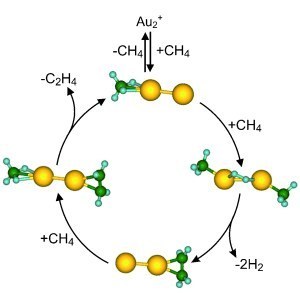A more environmentally friendly way to make ethylene (a primary feedstock for the chemical industry, which also goes by the name of ethene) would use natural gas as the raw material rather than cracking crude oil. Now, a golden opportunity in the form of a two-centred gold complex has come to light.
Ethylene is one of the chemical industry’s primary feedstock materials from which a whole range of different compounds are made, among them the coolant and antifreeze compound ethylene glycol and plastics such as polyethylene. Ethylene is currently produced from oil by steam cracking. However, direct conversion of natural gas, methane, to ethylene could also be viable on an industrial scale if a suitable catalyst and reaction setup were developed. One of the big advantages of such an approach is that methane supplies are likely to provide us with raw material long after oil has dwindled.
Scientists working with Thorsten Bernhardt at the University of Ulm, Germany and Uzi Landman at the Georgia Institute of Technology, in Atlanta, Georgia, USA, explain that the problem with the conversion of methane to ethylene is one of bond strength. The bonds between carbon and hydrogen atoms in the methane molecule, are very strong and so difficult to break. To compel the carbon in methane to form bonds with other carbon atoms requires a lot of energy. Additionally, any efforts to do so, usually produce lots of side-products containing more than the requisite two carbon atoms found in ethylene.
Activating methane to allow it to form bigger molecules, such as ethylene, is a complex process. The team explains that in order to find a suitable catalyst a clearer understanding of the process at the molecular level is needed. As such Bernhardt and colleagues investigated different catalytic metal clusters, aggregates of a few metal atoms, as model systems for the process. They found that particles containing two charged gold atoms (ions) in pairs could convert methane to ethylene at low temperatures and pressures in the gas phase without forming significant quantities of side-products.

In order to understand how this process works, the team “trapped” the reaction intermediates and used computational techniques to model the energy levels of starting materials, catalyst, intermediates, and products. They found that each gold ion in the dimer binds to a single methane molecule, this severs hydrogen from the methane and the two carbon atoms can then form a single bond to each other. This is a precursor to ethylene itself which has a strong double bond between its carbon atoms. The precursor initially remains bound to one of the gold ions, while the second gold ion, suddenly finds itself able to bond to a new methane molecule. In the final step, this second methane molecule nudges away the ethylene precursor, the carbon single bond, which can then form a carbon double bond. The newly trapped methane then pairs up with yet another methane and the cycle begins again.
“Both the activation of the carbon-hydrogen bonds of the methane and the subsequent splitting off of the ethylene molecule require cooperative action of several atoms bound to the gold dimer,” Berhnardt explains. “Our insights are not only of fundamental interest, but may also be of practical use.”
LINKS
Angew Chem Int Edn 2010, 49, 980-983
http://dx.doi.org/10.1002/anie.200905643
Bernhardt
http://www.uni-ulm.de/iok/bernhardt/